Haryana Government launches Asia’s first Gyps Vulture Reintroduction Programme
Haryana Government has launched Asia’s first ‘Gyps Vulture Reintroduction Programme’ at the Jatayu Conservation Breeding Centre at Pinjore.
It was launched by state Chief Minister Manohar Lal by releasing 2 captive bred Himalayan Griffons vultures in the pre-release aviaries close to the breeding centre at Pinjore.
The vultures were released as part of the soft release or reintroduction programme, in a pre-release aviary where they would have an unobstructive view of the surrounding. This would help them in getting used to the habitat in which they would be released in the wild in future. These birds have been wing-tagged and were leg-ringed for identification.
Himalayan Griffon vultures: They are closely related to the critically endangered resident Gyps species of vultures but are not endangered. The IUCN has listed this species as Near Threatened .
They are scavengers, preying on dead animals as they have a robust digestive system which can even digest disease-causing pathogens found in rotting meat of dead. Thus, they help in keeping environment clean.
Decline in vulture population
- The main reason for rapid decline in population of vulture is due to Diclofenac, a non-steroidal anti-inflammatory drug which is given to cattle in inflammation and pain.
- Though vultures have robust digestive system, they are not able to break down Diclofenac and die of renal failure or kidney failure after eating carcasses of cattle administered with the drug.
Preventive steps taken by Government
- The Diclofenac drug was banned by Union Government of India for veterinary use in 2006. It was banned to bring down prevalence of the drug in cattle carcasses and make the environment safe for vultures.
- Later in July 2015, the multi-dose vials of Diclofenac drug for human use were banned by the Drug Controller General of India.
Month: Current Affairs - June, 2016






